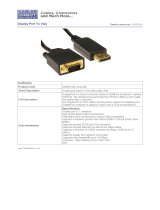
Table of contents
1 Getting started ............................................................................................................................................. 1
Important safety information ............................................................................................................................... 1
Product features and components ........................................................................................................................ 2
Features ............................................................................................................................................... 2
Front components ............................................................................................................................... 3
Rear components ................................................................................................................................ 4
Setting up the monitor .......................................................................................................................................... 5
Attaching the monitor stand ............................................................................................................... 5
Mounting the monitor head ................................................................................................................ 6
Removing the monitor stand ............................................................................................ 6
Attaching the monitor head to a mounting device ........................................................... 7
Connecting the cables ......................................................................................................................... 8
Adjusting the monitor ....................................................................................................................... 11
Installing a security cable ................................................................................................................. 12
Turning on the monitor ..................................................................................................................... 13
HP watermark and image retention policy ....................................................................................... 13
2 Using the monitor ........................................................................................................................................ 14
Downloading software and utilities .................................................................................................................... 14
The Information le ............................................................................................................................................. 14
The Image Color Matching le ............................................................................................................................. 14
Using the OSD menu ............................................................................................................................................ 14
Using the function buttons .................................................................................................................................. 15
Reassigning the function buttons ....................................................................................................................... 16
Changing the power mode setting ...................................................................................................................... 16
Using Auto-Sleep Mode ....................................................................................................................................... 16
Adjusting blue light output (select products only) .............................................................................................. 17
3 Support and troubleshooting ........................................................................................................................ 18
Solving common issues ....................................................................................................................................... 18
Button lockouts ................................................................................................................................................... 19
Using the auto-adjustment function (analog input) ........................................................................................... 19
Optimizing image performance (analog input) ................................................................................................... 20
Contacting support .............................................................................................................................................. 21
Preparing to call technical support ..................................................................................................................... 21
Locating the serial number and product number ............................................................................................... 21
v





















